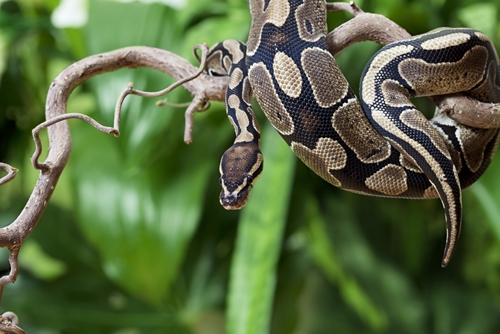



A paper recently published in the journal of Bioinspiration & Biomimetics has just shown that snake skin-inspired surfaces can provide a staggering 40 percent friction reduction in stress tests of high performance materials. By incorporating these designs into more widespread use, engineers could vastly improve the reliability of individual mechanical components in cars.
Biologists have known for quite some time that the skin patterns of snakes and lizards has been able to provide the animals with a reduction of friction as it moves as well as being resistant to wear in tear, especially in dry and sandy environments.
Dr. Christian Greiner led his team of scientists to test snake skin inspired designs in the lab by using a laser to etch the surface of several steel pins and measuring the effect the etching had on friction. In dry conditions, the scaly etched surface wound up creating somewhere in the realm of 40 percent less friction than the experiment's smooth control.
Talking about the weight of his team's discovery to physorg, Dr. Greiner said that if the team had "managed just a 1 percent reduction in friction, our engineering colleagues would have been delighted; 40 percent really is a leap forward and everyone is very excited!"
The most immediate applications of the pattern would be in small mechanical devices, especially those manufactured on the micro and nano scales. The sensors in anti-lock braking systems, for instance, could potentially be made with far more longevity and functionality.
The next step in Dr. Greiner's research is to make polymers that only decrease friction when moving in one direction, a field of development that could have direct applications in the field of robotic exploration.
For those who haven't felt a snake before, its scales are smooth in the direction the animal moves and extremely rough in the opposite direction, providing an overall texture ideal for exploring dusty environments. The patterns Dr. Greiner and his team etched into their steel pins managed to only mimic the surface texture, and wound up reducing friction in several directions.
Dr. Greiner says he's had some success in this new research stage, but that the work is very preliminary, and more development needs to be done before it's ready for publication. The one drawback to these developments is that the pattern only works in dry environments. In situations where a lubricant is involved, the pattern actually increases friction by as much as 300 percent.
Here at Greening Testing Laboratories, we strive to stay on the precipice of all of the latest industry trends. We're employed by many of the world's leading automakers to assess the performance of their vehicle brakes, components and materials. GM has recognized our facilities as suitable for the most demanding and accurate tests, following the guidelines of all major standards organizations.